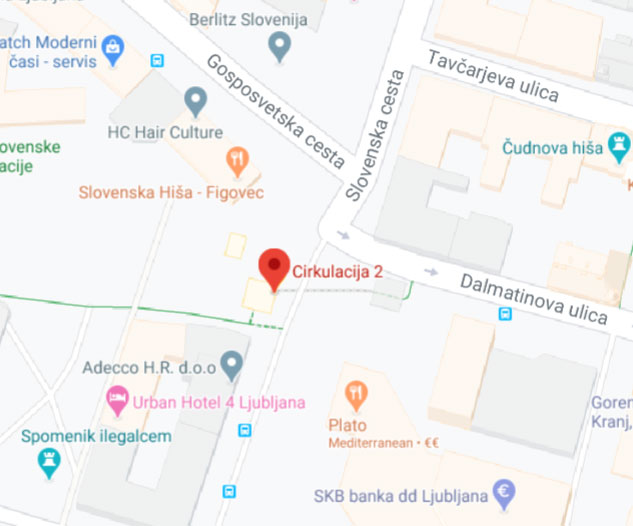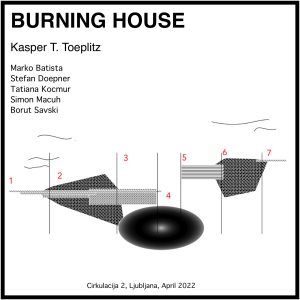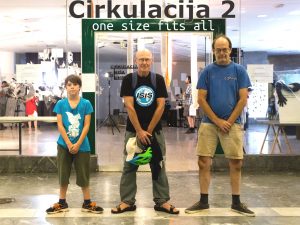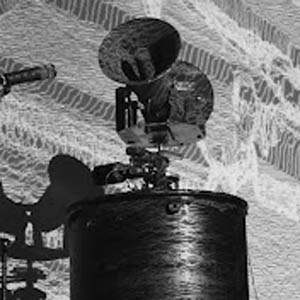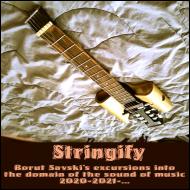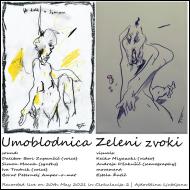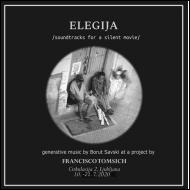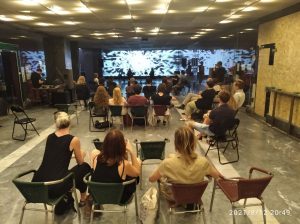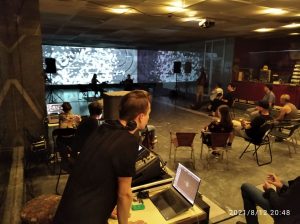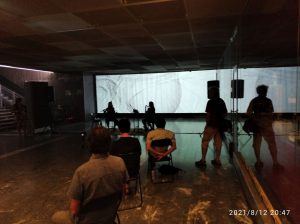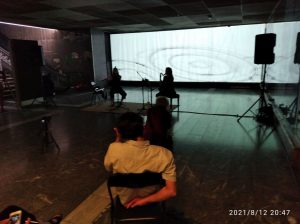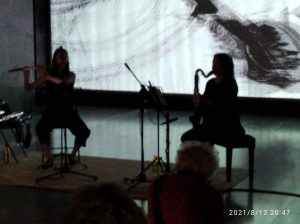FriFormA\V: LĪMEN
Published on August 8th, 2021[lang_si]Četrtek, 12. 8. 2021, ob 17.00 – Cirkulacija², Podhod Ajdovščina 2, 1000 Ljubljana
LĪMEN
Izvajalci/izvajalke:
· Tilen Lebar (elektronika in kompozicija)
· Anja Clift (flavte)
· Valentina Štrucelj (klarineti)
· Tomas Valečka (elektronika in oblikovanje zvoka)
· Stella Ivšek (vizualije)
I. prvi del šestkanalne zvočne instalacije, ob 17:00
II. vizualno glasbeni performans, ob 20:00
III. drugi del šestkanalne zvočne instalacije, ob 21:00
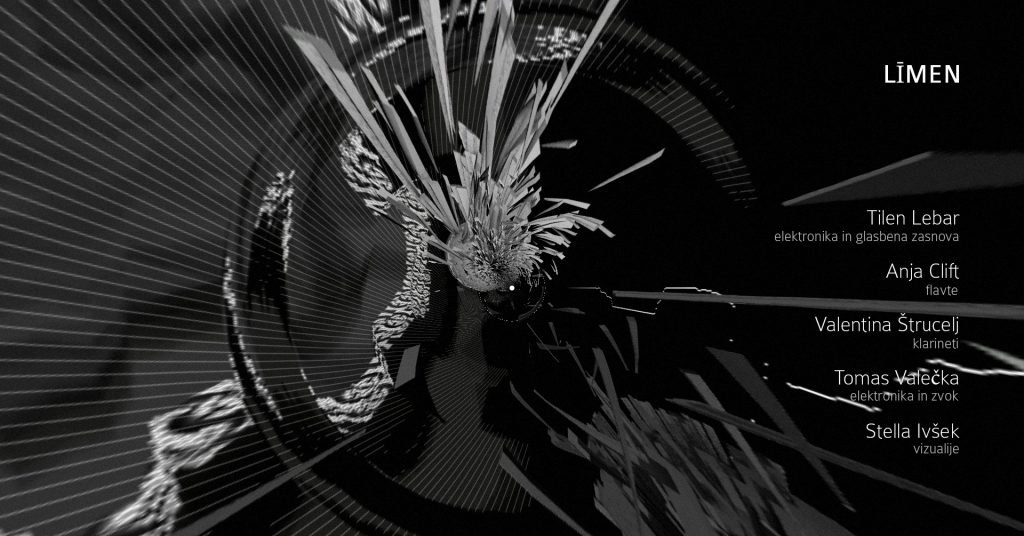
V februarju 2021 sem po spletu okoliščin naletel na termin ‘liminal spaces,’ ki v slovenskem prevodu nima drugačne označbe kot prehodni prostor. Tovrstna označba vključuje v svoj opis zapuščene stanovanjske objekte, hodnike, podhode, trgovske centre, pisarne, skladišča, tovarne itd. Prvotna namembnost vseh teh prostorov je seveda, da so zapolnjeni in obljudeni. S tem, ko postanejo zapuščeni, izgubijo tudi svoj prvotni namen. Ob obisku tovrstnih lokacij ljudje poročajo o individualnih ali celo kolektivnih emocionalnih in spominskih reakcijah, seveda znotraj širšega kulturnega okolja posameznice/posameznika, ki vključujejo dva fenomena, ki sta anemoia, ki se po svoji definiciji nanaša na doživljaj nostalgičnosti do časa ali obdobja, ki ga posameznica/posameznik nista doživela in kenopsia, ki označuje doživljanje atmosfere posameznega zapuščenega prostora, ki prinaša zunaj-kontekstualno zamolklost, ki prej ni bila prisotna, saj sta okolje ali prostor v svoje delovanje vključevala množice ljudi.
Prehodni prostori tako omogočijo izkustvo obeh omenjenih fenomenov. Ob nadaljnji raziskavi sem naletel na mnogoterost termina ‘liminal,’ ki se razteza čez panoge antropologije in folklore (npr., vključujeta iniciacijske obrede), religije (vključuje vsebine vnebohoda, reinkarnacije, itd.), psihologije (stanje samo-realizacije in prehodnost ter fazo razvijajoče se osebnosti) in filozofije (stanje). V primeru iniciacijskih obredov mi je teorija Arnolda van Gennepa približala antropološki pogled na prehodnost. Gennep je strukturiral termin ‘liminality’ in ga v tem kontekstu povezal z latinsko besedo Līmen, ki izraža ravno prehodnost ali prehod.
Fasciniranost nad tovrstno prehodnostjo in antropološkim definiranjem iniciacijskih obredov me je privedla do realizacije celovečernega dogodka Līmen, ki ravno tovrstno prehodnost prostora izraža skozi tridelno Gennepovsko strukturo. Na začetku lahko prisluhnemo ‘pre-liminality,’ ki na metaforičen način zapušča prvotno stanje in v tem primeru realizira minimalistično sozvočje šestkanalne zvočne instalacije. Okolje ne dopušča razvoja in je z vidika harmonije, zvoka in makroforme izredno statično. Notranje ravnovesje, ki se v tem primeru nanaša na ambisonična zvočna gibanja posameznih delcev harmonije, dopušča in opozarja na živost zvočnega materiala. V drugem delu večernega ‘obreda’ se vizualno zvočni dogodek v kontinuaciji nanese na drugo stopnjo ‘liminality.’ Makrostruktura drugega dela se navezuje na striktno predpisan sekvenčni razvoj dogodkov, ki tako omogočijo spremembe identitete prej omenjene statičnosti v ‘destruktivnost’ in težijo k razgibanosti zvoka znotraj mikro-procesov (vključujoč interference z mikrotonalnimi razlikami in utripajočo zvočnost) ter makrostrukturi, ki zaobjema razvoj harmonije v sosledju spektralnih akordov F#, Bb, D, E, A, C in D. Preko uporabe sintetičnih in analitičnih tehnik, kot so akustična odzivnost prostora, inštrumentov, ring modulacije, frekvenčne modulacije in spektralnega niza, se zvočnost drugega dela razgiba in nanese tranzicijo v tretji del celovečernega zvočnega dogodka Līmen.
Interpretacija zaključnega dejanja ponovno vključi šestkanalno zvočno instalacijo, ki tokrat ne vključuje ‘pre-liminality,’ temveč prinese zvočno refleksijo posameznih odcepov iz drugega sklopa ‘liminality’ v drugačno identiteto, ki je poimenovana ‘post-liminality.’ Z zaključnim delom se dogodek vrne k identiteti zvočne instalacije in vzpostavlja sintezo med statičnostjo ter sekvenčnim razvojem, ki kontinuirano zaokroži celovečerni zvočno vizualni dogodek.
/ Tilen Lebar
Organizator: KUD Mreža
V sodelovanju s Cirkulacijo 2
Podpora: Ministrstvo za kulturo RS, MOL – Oddelek za kulturo
[lang_en] Thursday, 12. 8. 2021, at 5pm – Cirkulacija², Podhod Ajdovščina 2, 1000 Ljubljana
LĪMEN
Performers:
· Tilen Lebar (electronics and composition)
· Anja Clift (flutes)
· Valentina Štrucelj (clarinets)
· Tomas Valečka (electronics and sound design)
· Stella Ivšek (visuals)
I. first part of the six-channel sound installation, at 5 p.m.
II. visual music performance, at 8 p.m.
III. second part of the six-channel sound installation, at 9 p.m.

From the beginning of year 2021 and throughout February, I encountered the phenomenon of liminal space. As a starting point, I investigated the phenomenon itself and consequentially translated it into Slovene. Therefore, the translation indicated as ‘Prehodni Prostor’ became the topic of my following research.
Liminal spaces are thresholds or abandoned residential buildings, areas, corridors, hallways, underground pathways, shopping malls, office buildings, etc. Their initial purpose is to serve as a space crowded with people. The act of abandonment loses their initial desire. The individuals who visited such abandoned areas for the first time reported emotional and memory responses of the spaces itself. These responses are related to two terms. The first one is Anemoia that indicates nostalgia or excitement of a time you have never known. The second Kenopsia describes a particular Psychophysiological response of an individual who interacted with the liminal space and experienced its atmosphere. We could say that liminal spaces enable us to experience these phenomena. Liminal as a cross-disciplinary term is used widely within anthropology and folklore (e.g., initiation rituals), religion and spirituality (e.g., Ascension Day, reincarnation, etc.) and psychology (e.g., self-realisation and a state of mind within constructing and developing a personality). For instance, if we take a closer look at the theory of Arnold van Gennep, he invented the term ‘Liminality’ at the beginning of the 20th century.
The direct relation to the Latin word Līmen is comprehensive and indicates the threshold and passageway at the same time. Fascinated by the term, its sense of fluidity and the anthropological theory behind it, I was inspired to write an original work. The work itself has three parts. The first movement named ‘Preliminality’ includes metaphorical deviation of the present state and forms a minimalistic and repetitive sonic environment throughout the six-channel sound installation. The ‘Preliminality’ does not evolve. It is somehow static (i.e., from the harmony, sound and the macro form point of view). The ambisonic movements throughout the sound installation allow it to come to life and to arouse. In the second part of the audiovisual event Līmen (or an audiovisual rite) is the ‘Liminality.’
The sense of sequential development comes along. The identity changes and transitions through a ‘destructive’ progression of the viable sounds of micro-processes (i.e., interferences and beatings with microtonal changes). The macro form and the spectral chords (following F#2, Bb1, D1, E2, A1, C1 & D2) enable further development. Moreover, the sonic environment of the second movement becomes fluid and transitions into the third part of the Līmen itself. This is achieved through the use of different synthetical and analytical techniques (i.e., the acoustic response of the space, instrumental acoustics, Ring Modulation, Frequency Modulation & harmonic spectrum). ‘Postliminality’ becomes the conclusion of the event that reflects ‘Liminality’ and takes over a new identity. Accordingly, the sound installation comes along. It meticulously draws a parallel with the two previous movements and loops in a circle of the static environment.
/ Tilen Lebar
Organizator: KUD Mreža
In collaboration with Cirkulacija 2
Supported by: Ministry of Culture of the Republic of Slovenia, City of Ljubljana – Department of Culture




